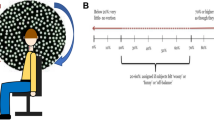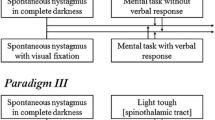Abstract
Cervical stimulation in the horizontal plane induces small and variable eye movements in normal human adults [cervico-ocular reflex (COR)]. In patients with bilateral vestibular loss, the slow COR component increases in amplitude and is thought to contribute to gaze stabilization during head movements, as it is directed opposite to head-on-trunk excursions. The procedures underlying COR slow phase gain enhancement in the compensatory direction remain unclear. We studied the horizontal COR during passive trunk oscillations of ±16° under the stationary head at 0.1 Hz in ten normal subjects, aged 24–30 years, before and immediately after the application of an adaptation procedure engaging various combinations of sinusoidal neck-proprioceptive, pursuit and retinal slip signals. The duration of this adaptation period was 40 min. A significant gain increase and phase modulation in the compensatory direction were observed in four out of eight subjects after exposing them to neck-proprioceptive stimulation, while pursuing a spot moving in-phase with their trunk. In contrast, staring at the rotating optokinetic pattern or fixating at a stationary spot, while being subjected to combined cervical and optokinetic stimulation, failed to result in any significant modification of the subjects’ COR gain and phase. Conceivably, the contribution of the pursuit system was greatly reduced in the paradigm using optokinetic stimulation, while full engagement of retinal slip signals, in the absence of any pursuit contribution, was obtained in the latter adaptation paradigm. These results indicate that motor responses of target tracking rather than simply sensory signals of retinal slip may represent the ‘error signal’ modifying the COR in humans.





Similar content being viewed by others
References
Anastasopoulos D, Mandellos D, Kostadima V, Pettorossi VE (2002) Eye position signals modify vestibulo- and cervico-ocular fast phases during passive yaw rotation in humans. Exp Brain Res 145:480–488
Anastasopoulos D, Nasios G, Psilas K, Mergner Th, Maurer C, Lücking CH (1998) What is straight ahead to a patient with torticollis? Brain 121:91–101
Bárány R (1919) Über einige Augen-und Halsmuskelreflexe bei Neugeborenen. Acta Otolaryngol 1:97–102
Barnes GR, Forbat LN (1979) Cervical and vestibular afferent control of oculomotor response in man. Acta Oto Laryngol 88:79–87
Bronstein AM, Hood JD (1986) The cervico-ocular reflex in normal subjects and patients with absent vestibular function. Brain Res 373:399–408
Bronstein AM, Mossman S, Luxon LM (1991) The neck–eye reflex in patients with reduced vestibular and optokinetic function. Brain 114:1–11
Chambers BR, Mai Mabel, Barber HO (1985) Bilateral vestibular loss, oscillopsia, and the cervico-ocular reflex. Otolaryngol Head Neck Surg 93(3):403–407
Demer JL, Porter FI, Goldberg J, Jenkins HA, Schmidt K (1989) Adaptation to telescopic spectacles: vestibulo-ocular reflex plasticity. Invest Ophthalmol Vis Sci 30(1):159–170
Demer JL, Robinson DA (1982) The effect of reversible lesions and electrical stimulation of the olivocerebellar system on vestibulo-ocular reflex plasticity. J Neurophysiol 47(6):1084–1107
Dichgans J, Bizzi E, Morasso P, Taliasco V (1973) Mechanisms underlying recovery of eye-head coordination following bilateral labyrinthectomy in monkeys. Exp Brain Res 18:548–562
Dieterich M, Bucher SF, Seelos KC, Brandt T (1998) Horizontal or vertical optokinetic stimulation activates visual motion-sensitive, ocular motor and vestibular cortex areas with right hemispheric dominance. fMRI Study Brain 121:1479–1495
Du Lac S, Raymond JL, Sejnowski TJ Lisberger SG (1995) Learning and memory in the vestibulo-ocular reflex. Ann Rev Neurosci 18:409–441
Gellman RS, Carl JR, Miles FA (1990) Short latency ocular following responses in man. Vis Neurosci 5:107–122
Gonshor A, Melvill Jones G (1976) Extreme vestibulo-ocular adaptation induced by prolonged optical reversal of vision. J Physiol Lond 256:381–414
Gurfinkel VS, Levik YS (1993) The suppression of the cervico-ocular response by the haptokinetic information about the contact with a rigid, immobile object. Exp Brain Res 95:359–364
Heimbrand S, Bronstein A, Gresty M, Faldon M (1996) Optically induced plasticity of the cervico-ocular reflex in patients with bilateral absence of vestibular function. Exp Brain Res 112:372–380
Honrubia V, Downey WL, Mitchell DP, Ward PH (1968) Experimental studies on optokinetic nystagmus II. Normal humans. Acta Oto-Laryngol 65:441–448
Huygen PLM, Verhagen WIM, Nicolasen MGM (1991) Cervico-ocular reflex enhancement in labyrinthine-defective and normal subjects. Exp Brain Res 87:457–464
Ito M (1993) New concepts in cerebellar function. Rev Neurol (Paris) 149(11):596–599
Kasai T, Zee DS (1978) Eye-head coordination in labyrinthine-defective human beings. Brain Res 144:123–141
Keller EL, Smith MJ (1983) Suppressed visual adaptation of the vestibuloocular reflex in catecholamine-depleted cats. Brain Res 258(2):323–327
Lisberger SG (1988) The neural basis for motor learning in the vestibulo-ocular reflex in monkeys. Trends Neurosci 11:147–152
Lisberger SG, Miles FA, Zee DS (1984) Signals used to compute errors in monkey vestibuloocular reflex: possible role of flocculus. J Neurophysiol 52:1140–1153
Maurer C, Kimmig H, Trefzer A, Mergner T (1997) Visual object localization through vestibular and neck inputs. 1: localization with respect to space and relative to the head and trunk mid-sagittal planes. J Vestib Res 7(2–3):119–135
Mergner T, Schweigart G, Botti F, Lehmann A (1998) Eye movements evoked by proprioceptive stimulation along the body axis in humans. Exp Brain Res 120:450–460
Miles FA, Lisberger SG (1981) Plasticity in the vestibulo-ocular reflex: a new hypothesis. Ann Rev Neurosci 4:273–299
Rambold H, Churchland A, Selig Y, Jasmin L, Lisberger SG (2002) Partial ablations of the flocculus and ventral paraflocculus in monkeys cause linked deficits in smooth pursuit eye movements and adaptive modification of the VOR. J Neurophysiol 87:912–924
Rijkaart DC, van der Geest JN, Kelders WP, de Zeew CI, Frens MA (2004) Short-term adaptation of the cervico-ocular reflex. Exp Brain Res 156:124–128
Shelhamer M, Tiliket C, Roberts D, Kramer PD, Zee D (1994) Short-term vestibulo-ocular reflex adaptation in humans II. Error Signals Exp Brain Res 100:328–336
Ter Braak JWG (1936) Untersuchungen über optokinetischen Nystagmus. Arch Neerl Physiol 21:309–376
Wilson VJ, Maeda M, Franck JI (1975) Inhibitory interaction between labyrinthine, visual and neck inputs to the cat flocculus. Brain Res 96:357–360
Author information
Authors and Affiliations
Corresponding author
Rights and permissions
About this article
Cite this article
Mandellos, D., Anastasopoulos, D. & Becker, W. Smooth pursuit rather than visual signals mediate short-term adaptation of the cervico-ocular reflex in humans. Exp Brain Res 169, 153–161 (2006). https://doi.org/10.1007/s00221-005-0134-7
Received:
Accepted:
Published:
Issue Date:
DOI: https://doi.org/10.1007/s00221-005-0134-7




